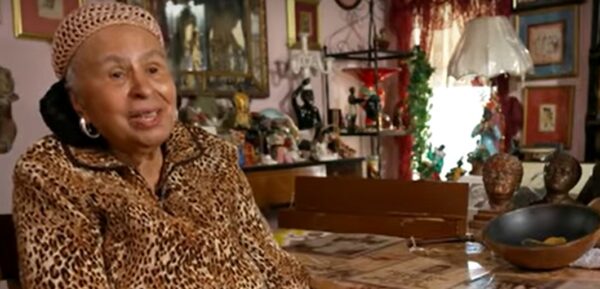A former Staten Island teacher, who amassed a 20,000-piece collection of artifacts reflecting the African American experience, will place the lot up for auction. The 90-year-old Black woman — asking the question, “What is the value of the story of a people?” — will start the bid at one million dollars.
According to CBS, the collection’s owner and curator Elizabeth Meaders has been acquiring pieces for the last 60 years, storing them in her modest Staten Island home. Meadors has decided to work with Guernsey’s Auction House to sell the properties that she calls the “African American History Trust Collection.”

The nonagenarian said that she was “obsessed with collecting African-American history,” and it has “soothed her soul” to preserve the history for all people.
She said that she wanted to create a “patriotic healing and teaching instrument, to compensate for the fact that as a teacher and just as an ordinary citizen” she knows “that African-American history has been completely omitted from American history.”
Her statements come as a wave of states have adopted anti-critical race theory legislation, that prevents teachers from exploring aspects of Black history like slavery and civil rights because it allegedly promotes societal guilt and makes children feel bad about being white.
Meaders has organized the pieces, which included thousands of posters, books, slave shackles, clothing, statues, rare photographs and various other artifacts, by eras and themes, occupying every part of her home. “I have 14 museums in my house,” she said.
One photo in her collection is a picture of “slaves being branded,” a “bronze statue of Joe Lewis” and a pair of Muhammad Ali’s shoes in her lot.
Arlan Ettinger of Guernsey’s Auction House boasted about Meader’s collection, saying, “There’s never been an auction of a large collection being sold as a collection like this.”
The representative from the auction house challenged New York City’s mayor by name to step up and consider purchasing the collection, hoping to keep the artifacts local.
“Hey, Mayor Adams, come on. New York City, with all its greatness, does not have a full-blown African American Museum, and you’ve got one sitting here on Staten Island,” he said.
New York City does have some institutions exclusively dedicated to preserving Black history. Some of the most prominent ones are Schomburg Center for Research in Black Culture in Harlem; the African Burial Ground, a six-acre memorial in Manhattan; the Sandy Ground Historical Society Museum in Staten Island and the Weeksville Heritage Center in Brooklyn.
The problem is that many of these organizations that preserve Black history struggle with funding. The Hue Arts NYC “Brown Paper” report shows how Weeksville, a historic site in Brooklyn dedicated to one of the country’s first free Black communities, has operated in a deficit for years and has struggled to keep its doors open, resulting in them partaking in a community crowdfunding campaign to raise the funds to preserve the history.
NYC Speaks recently released some of the results of a survey taken by over 60,000 New Yorkers about things they would like Mayor Adams’ administration to address. Many said that while preserving Black cultural and art institutions are top of mind for citizens, citizens also want the city to invest in it.
“As Black people in America, we know that funding for cultural institutions that celebrate our history and legacy is minimal,” Rose Guerrier, NYC Speaks’ co-chair of Arts and Culture, told Atlanta Black Star.
“Our survey allowed the people to express to the new mayor that an investment in our art, cultural institutions, and even collections like Mrs. Meaders; would be a philanthropic move that reflects the core feelings of thousands of New Yorkers.”
The country’s lack of investment in Black history is why Meaders saw the urgency in collecting the items when she started this journey in the 1960s. She said, “Everywhere, every day Black history is being made. So, it’s up to us to embrace it, respect it, and promote it.”
Meaders hopes that the collection is sold at the auction to the right buyer, who would put the collection on display and like other museums be an educational supplement — specifically about Black life — to millions.
Meaders charged potential buyers to consider the range of investment that collectors make for items that they have an interest in, especially in spaces of pop culture. She urges those interested to juxtapose the value of Black history to those big-ticket auctions.
“Two million dollars for a baseball card; five million dollars for Marilyn Monroe’s dress. What is the value of the story of a people? That’s the question that this collection is trying to answer.”
Her dream buyer, she shared, would be the 44th president of the United States, Barack Obama, hoping he would consider acquiring the pieces for his presidential library.


